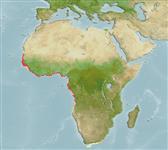Common names from other countries
Environment: milieu / climate zone / depth range / distribution range
Ecología
; rango de profundidad 1 - 55 m (Ref. 435), usually 10 - 30 m (Ref. 435). Tropical; 20°N - 17°S
Distribución
Países | Áreas FAO | Ecosistemas | Ocurrencias, apariciones | Introducciones
Eastern Atlantic: from Mauritania to Angola.
Length at first maturity / Tamaño / Peso / Age
Maturity: Lm ? range ? - ? cm Max length : 9.3 cm CL macho / no sexado; (Ref. 435)
Maximum carapace width: 19.0 cm (Ref. 435). Also caught by trammel nets (Ref. 417). Occurs at depths from 1 to 55 m, common at depths of 10 to 30 m. Inhabits shallow coastal waters with bottoms consisting of sand or mud (Ref. 435).
Life cycle and mating behavior
Madurez | Reproducción | Puesta | Huevos | Fecundidad | Larva
Members of the order Decapoda are mostly gonochoric. Mating behavior: Precopulatory courtship ritual is common (through olfactory and tactile cues); usually indirect sperm transfer.
Fischer, W., G. Bianchi and W.B. Scott (eds.). 1981. (Ref. 435)
IUCN Red List Status (Ref. 130435)
CITES status (Ref. 108899)
Not Evaluated
Not Evaluated
Threat to humans
Harmless
Human uses
Pesquerías: comercial
| FishSource |
Herramientas
Fuentes de Internet
Estimates based on models
Preferred temperature
(Ref.
115969): 22.7 - 28, mean 26.6 (based on 50 cells).
Vulnerability
Low vulnerability (10 of 100).
